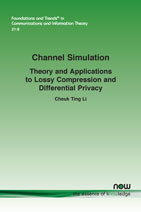Channel Simulation: Theory and Applications to Lossy Compression and Differential Privacy
By Cheuk Ting Li, The Chinese University of Hong Kong, China, ctli@ie.cuhk.edu.hk
Abstract
One-shot channel simulation (or channel synthesis) has seen increasing applications in lossy compression, differential privacy and machine learning. In this setting, an encoder observes a source X, and transmits a description to a decoder, so as to allow it to produce an output Y with a desired conditional distribution PY|X. In other words, the encoder and the decoder are simulating the noisy channel PY|X using noiseless communication. This can also be seen as a lossy compression scheme with a stronger guarantee on the joint distribution of X and Y. This monograph gives an overview of the theory and applications of the channel simulation problem. We will present a unifying review of various one-shot and asymptotic channel simulation techniques that have been proposed in different areas, namely dithered quantization, rejection sampling, minimal random coding, likelihood encoder, soft covering, Poisson functional representation, and dyadic decomposition.
Channel Simulation: Theory and Applications to Lossy Compression and Differential Privacy
One-shot channel simulation, or channel synthesis, has seen increasing applications in lossy compression, differential privacy and machine learning. In this setting, an encoder observes a source X, and transmits a description to a decoder, so as to allow it to produce an output Y with a desired conditional distribution PY|X. In other words, the encoder and the decoder are simulating the noisy channel PY|X using noiseless communication. This can also be seen as a lossy compression scheme with a stronger guarantee on the joint distribution of X and Y
This monograph gives an overview of the theory and applications of the channel simulation problem. A unifying review of various one-shot and asymptotic channel simulation techniques that have been proposed in different areas are presented, namely dithered quantization, rejection sampling, minimal random coding, likelihood encoder, soft covering, Poisson functional representation, and dyadic decomposition.
